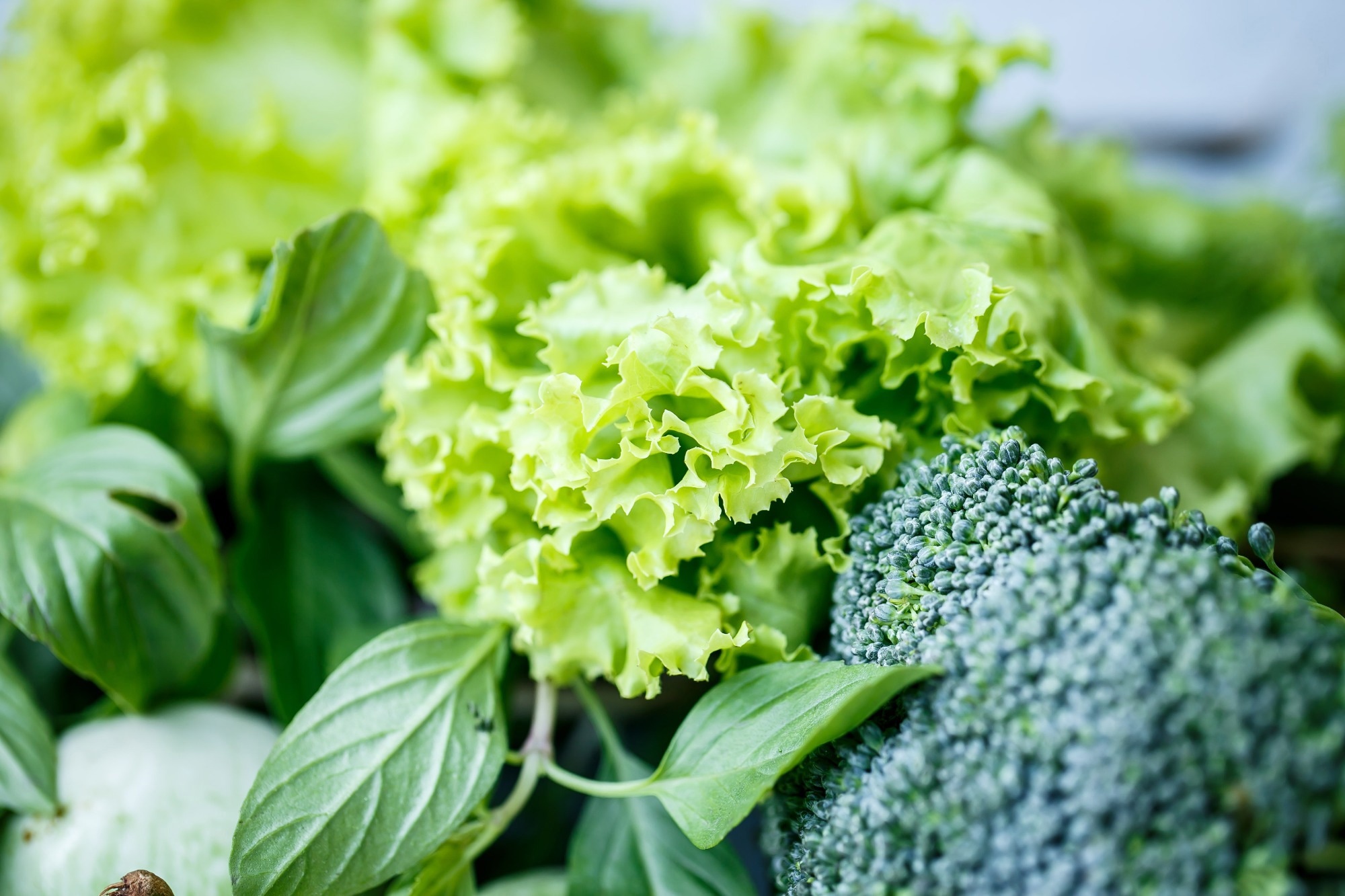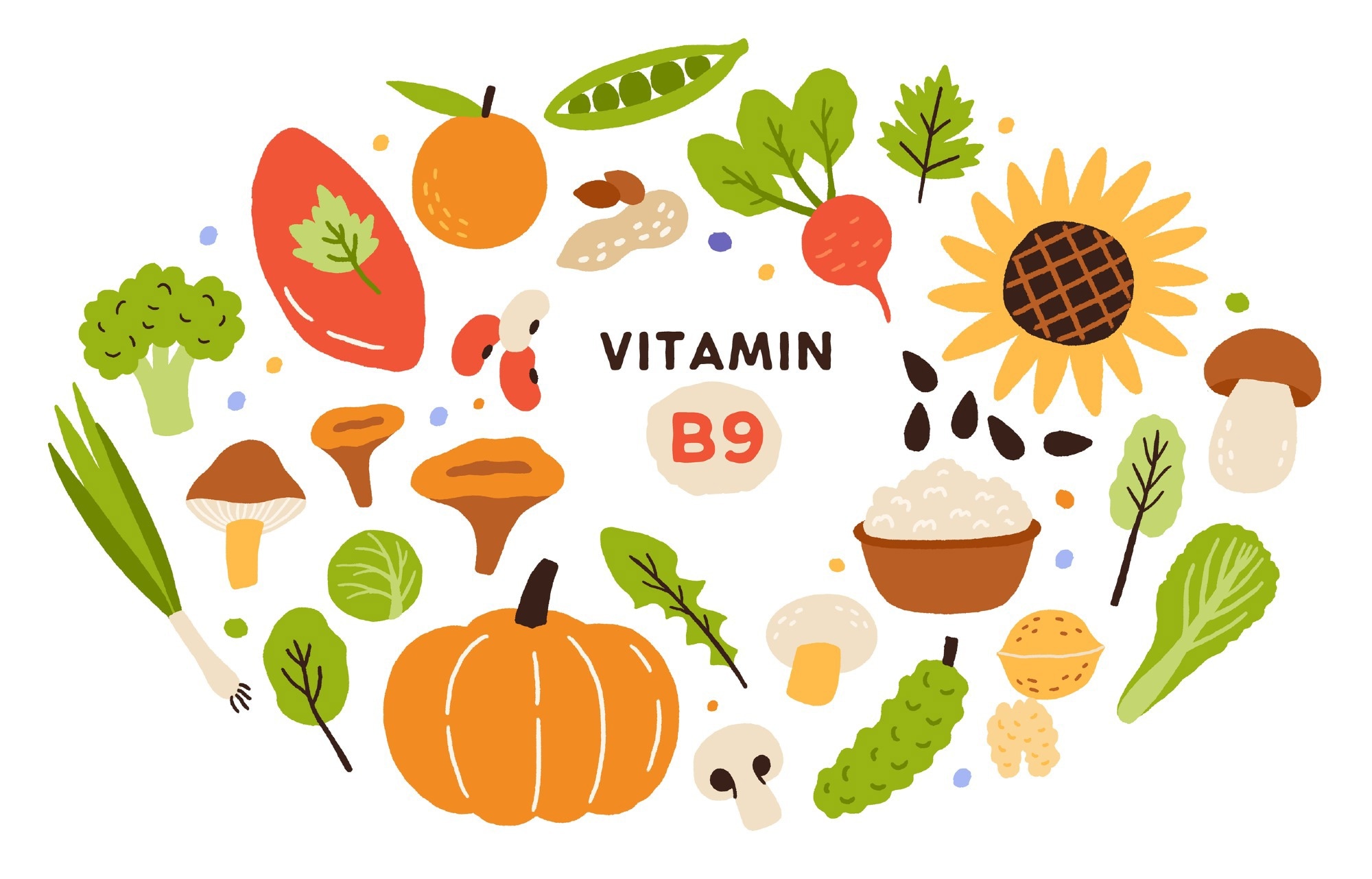Introduction
What is folate and why is it important?
Folate-rich foods
Health benefits of folate
Safety and excess intake
Conclusions
References
Further reading
Folate, an essential B vitamin, supports DNA synthesis, cell growth, and brain development, while preventing neural tube defects and maintaining cardiovascular and neurological health. A balanced intake from leafy greens, legumes, fortified foods, and supplements ensures optimal metabolism throughout life.
 Image Credit: Boiarkina Marina / Shutterstock.com
Image Credit: Boiarkina Marina / Shutterstock.com
Introduction
Folate, otherwise known as vitamin B9, acts as a one-carbon cofactor for deoxyribonucleic acid (DNA) synthesis, repair, and methylation. It participates in interconnected folate and methionine cycles that regulate nucleotide biosynthesis, redox balance, and epigenetic methylation processes critical to cellular and neurological function. Natural folate is present in leafy greens, legumes, and animal liver as reduced polyglutamates, while folic acid is the fully oxidized synthetic form used in supplements and fortified foods that must be reduced via dihydrofolate reductase (DHFR) to become biologically active.1
Adequate folate intake is imperative during pregnancy to prevent neural tube defects (NTDs), support placental growth, and reduce the risk of other adverse outcomes. Supplementation before conception and through the first trimester, at approximately 400 µg folic acid per day, has consistently been shown to lower NTD incidence by about 35% globally. Throughout life, folate supports neurological health through methylation, neurotransmitter synthesis, hematopoiesis, tissue repair, and genomic stability.1,2
What is folate and why is it important?
Folate is a water-soluble B vitamin that functions as a coenzyme in one-carbon metabolism, supplying methyl groups for purine and pyrimidine synthesis and amino-acid interconversions. This process sustains DNA and RNA formation and helps regulate gene expression through methylation reactions. It also facilitates the remethylation of homocysteine to methionine, a reaction dependent on vitamin B12, which maintains cellular methylation potential and reduces homocysteine accumulation linked to vascular risk.1,3
Hematologically, folate and vitamin B12 enable red blood cell production and maturation, preventing megaloblastic anemia. During pregnancy, folate is vital for neural tube closure and early neurodevelopment, and its deficiency can impair fetal growth and increase NTD risk. Therefore, women are advised to consume 400 µg folic acid daily from preconception through early gestation to ensure sufficient maternal-fetal folate status.2
Folate-rich foods
Dark leafy greens and salad vegetables, particularly spinach and watercress, are rich in folate. Other high-folate foods include kale, collard greens, chickpeas, lentils, peas, and beans, which can provide 40–100% of daily requirements per serving. Tomatoes, cucumbers, carrots, peppers, celery, radish, red cabbage, corn, and avocados also contribute smaller amounts.1,3,4
According to large-scale intake studies, vegetables contribute about 31% and cereals about 23% of daily folate intake among women of reproductive age, with fortified grains and breakfast cereals further improving folate adequacy where mandatory fortification exists. Fruits such as bananas, kiwifruit, tangerines, apples, pears, strawberries, and papaya add additional natural folate.1,4
Ready-to-eat breakfast cereals supply synthetic folic acid that complements dietary folate from produce and legumes. Nuts such as hazelnuts, walnuts, and almonds also provide folate along with fiber and micronutrients. Research indicates that consuming folate-rich foods can lower plasma homocysteine concentrations comparably to folic acid supplements, supporting their cardiovascular benefit.3
Although animal sources (e.g., liver) provide moderate folate levels, a mixed diet of plant and fortified foods is recommended for consistent intake.3,4
 Image Credit: GoodStudio / Shutterstock.com
Image Credit: GoodStudio / Shutterstock.com
Table 1. The richest natural food sources of folate and their nutrient contents.
| Natural Food Sources of Folate |
Folate Content (µg/100 g) |
% of Recommended Daily Intake (per 100 g) ¹ |
Leafy green
vegetables |
Spinach |
194 |
48.5 |
| Collard greens |
129 |
32.2 |
| Kale |
62 |
15.5 |
| Swiss chard |
14 |
3.5 |
| Legumes |
Lentils |
181 |
45.2 |
| Chickpeas |
172 |
43.0 |
| Beans |
149 |
37.2 |
| Peas |
65 |
16.2 |
| Fruits |
Avocado |
81 |
20.2 |
| Strawberries |
50 |
12.5 |
| Papaya |
37 |
9.2 |
| Oranges |
30 |
7.5 |
| Whole grains |
Quinoa |
42 |
10.5 |
| Oats |
32 |
8.0 |
| Barley |
19 |
4.8 |
| Brown rice |
9 |
2.2 |
¹ Considering 400 µg as the recommended daily intake of folate for teens and adults.
Health benefits of folate
Folate participates in amino acid and neurotransmitter biosynthesis, as well as broader methylation pathways that influence neural gene expression and cognition. Deficiency or dysregulation in folate metabolism increases homocysteine and oxidative stress, mechanisms implicated in neurodegenerative disorders, including Alzheimer’s and Parkinson’s disease.1
At the cellular level, folate is essential for DNA and RNA synthesis and repair, sustaining tissue growth and regeneration in rapidly dividing cells like bone marrow and fetal tissues. Its cofactor 5-methyltetrahydrofolate (5-MTHF) donates methyl groups for nucleotide synthesis and methionine cycling, supporting genomic stability, protein synthesis, and antioxidant defense via glutathione production.1,2
Folate supports cardiovascular health by enabling remethylation of homocysteine to methionine. Adequate folate status helps maintain normal homocysteine levels, reducing endothelial dysfunction and vascular risk.3
Folate deficiency raises the risk of megaloblastic anemia and adverse pregnancy outcomes and may cause fatigue, irritability, or oral ulcers. Predictors of higher folate intake include vegetarian diets, better nutritional knowledge, more frequent meals, and higher physical activity, while low activity, smoking, and fewer meals correlate with inadequate intake.4
Safety and excess intake
High-dose folic acid (>5 mg/day) can correct the anemia of vitamin B12 deficiency but may mask its neurological progression, leading to delayed diagnosis. Current clinical evidence indicates that excessive folic acid in individuals with low B12 can worsen cognitive decline and elevate homocysteine and methylmalonic acid levels, possibly by reducing holotranscobalamin availability.5
Toxicity concerns apply mainly to synthetic folic acid, as naturally occurring folate has low toxicity. Because of the close metabolic relationship between folate and vitamin B12, clinicians should monitor B12 status in older adults, vegetarians, those with malabsorption or on metformin or acid-suppressing therapy, and anyone on long-term high-dose folic acid.5 Individuals who consume both supplements and folate-rich foods should seek professional advice to balance folate and B12 intake.5
Conclusions
Folate is essential for DNA synthesis, red blood cell formation, and neurodevelopment. From preconception through early pregnancy, sufficient folate levels reduce neural tube defect risk and support placental and fetal brain development. Beyond reproduction, optimal folate metabolism maintains cognitive and cardiovascular health through regulation of methylation, antioxidant defense, and homocysteine control.1,2,3
Consuming folate-rich foods such as dark leafy greens, legumes, citrus, berries, avocados, and fortified grains helps achieve adequate intake. When dietary sources are insufficient, supplementation with folic acid under clinical guidance, while ensuring adequate vitamin B12, offers a safe and effective strategy for maintaining metabolic and neurological health.5
References
- Sobral, A. F., Cunha, A., Silva, V., et al. (2024). Unveiling the Therapeutic Potential of Folate-Dependent One-Carbon Metabolism in Cancer and Neurodegeneration. International Journal of Molecular Sciences 25(17). DOI:10.3390/ijms25179339, https://www.mdpi.com/1422-0067/25/17/9339
- Tola, F. S. (2024). The concept of folic acid supplementation and its role in prevention of neural tube defect among pregnant women: PRISMA. Medicine 103(19). DOI:10.1097/MD.0000000000038154, https://journals.lww.com/md-journal/fulltext/2024/05100/the_concept_of_folic_acid_supplementation_and_its.18.aspx
- Pintó, X., Vilaseca, M. A., Balcells, S., et al. (2005). A folate-rich diet is as effective as folic acid from supplements in decreasing plasma homocysteine concentrations. International Journal of Medical Sciences 2(2):58–63. DOI:10.7150/ijms.2.58, https://www.medsci.org/v02p0058.htm
- Sicinska, E., Kubiak, K., Madej, D., et al. (2024). Main sources and predictive factors of folate intake in female university students. Nutrition 120. DOI:10.1016/j.nut.2024.112359, https://www.sciencedirect.com/science/article/pii/S0899900724000091
- Miller, J. W., Smith, A., Troen, A. M., et al. (2024). Excess folic acid and vitamin B12 deficiency: clinical implications? Food and Nutrition Bulletin 45(1):S67–S72. DOI:10.1177/03795721241229503, https://journals.sagepub.com/doi/10.1177/03795721241229503
Further Reading
Last Updated: Oct 12, 2025